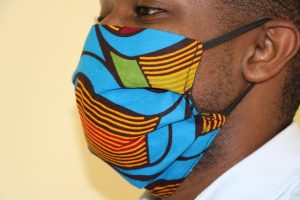NIA CHARLESTOWN NEVIS (June 10, 2020) — Dr. Judy Nisbett, Chairman of the Nevis COVID-19 Task Force, urged Nevisians to take note and adhere to the World Health Organization’s (WHO) recently published updated guidelines on the production and use of fabric masks.
During her presentation at the Nevis COVID-19 Task Force briefing on June 08, 2020, Dr. Nisbett used the opportunity to enlighten the public on the recommended methods of production, use and care of the fabric masks.
“WHO has advised that the cloth covering being made at home or by local manufacturers, be made ideally of a minimum of three layers, with an innermost layer (that is the layer that is touching the face) be made of cotton or a cotton blend. This is called a hydrophobic layer, meaning that this layer is absorbent and it will absorb the droplets coming from one’s nose and mouth.
“The outermost layer should be made of a hydrophobic material (that is a material that is repellent and repels droplets from other persons from penetrating through to your nose). Such materials are polyester, for example, or polypropylene [material used to manufacture sportswear and

cold weather garments].
“The middle layer should be hydrophobic also and should preferably be polypropylene. This is appropriate because it has a tight weave which is great for filtration, and therefore a good barrier preventing droplets from leaving but offers breathability so that persons can breathe easily… If that material is not available a cotton layer could be used,” she explained.
Dr. Nisbett further advised that once constructed the fabric masks should be flat fold or have a duckbill shape and cover the nose, cheek and chin. It must be comfortable and held in place with little adjustment.
“Why we say it should be held in place with little adjustment is because we don’t want persons to be handling the outside of the mask, and keep handling it because the outside of the mask, you could appreciate, would have droplets from other persons, and it means that it’s dirty and every time you handle it you should actually be sanitizing your hand. So once it is comfortable and it sits there that is what we want,” she said.
Dr. Nisbett also stated that coating the masks with wax to repel water is not recommended since it would affect how well one could breathe in the mask.
The Nevis COVID-19 Task Force Chairman also underscored the importance of only one user per mask.
“Masks should be used by one person and not shared. Usually a mask can be worn for a day but if it gets wet because of the amount of speaking you have been doing, you need to remove that mask and use a clean one. So it’s advisable then to always have a spare mask with you,” she said.
Dr. Nisbett advised on the methods that should be applied to keep the fabric masks clean.
She stated that they should be frequently washed, preferably hand-washed in hot water or in a washing machine set on a gentle cycle to avoid the mask losing its shape which would result in rendering the mask useless.
Dr. Nisbett also urged persons to put on and remove the masks correctly and safely. That process was demonstrated in a short video which can is available on the WHO website.
If anyone needs further information regarding WHO recommendations for making masks, they can find these on the WHO website or can contact the Health EOC at 469-1423.
The Nevis COVID-19 Task Force Chairman reminded the public that the use of face masks for infection is for prevention and control in the context of the COVID-19 pandemic and is used as a measure to limit the spread of the disease.
“We are aware that three groups of persons can spread infectious droplets.
“The first group is persons who have symptoms and are coughing and sneezing. These persons should be at home and they should seek medical care, and these persons should actually be wearing medical masks.
“The other two groups that can spread infectious droplets are persons who are not yet symptomatic that is termed pre-symptomatic. They are in the incubation period and will later have symptoms, and then there are persons who are infected but will never get symptoms and that is they will always be asymptomatic.
“Now let’s look at the two last groups. They appear healthy. So the reasons we ask persons to wear masks is because we, any of us, can be pre-symptomatic, not yet showing symptoms; or asymptomatic, will never show symptoms; and unknowingly spread the virus to others. In other words we are protecting others from ourselves,” she said.
